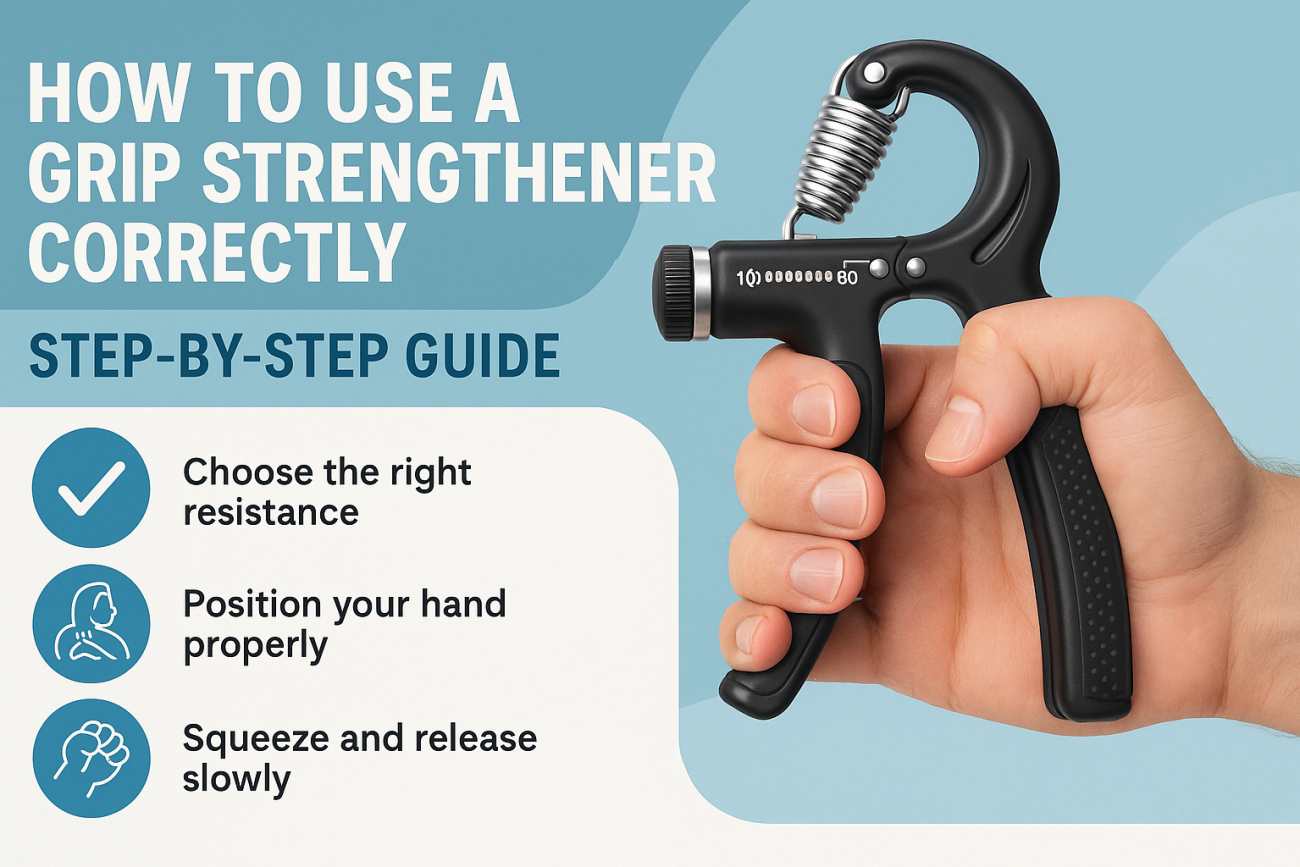Grip strength is essential for a variety of daily tasks and sports activities. Whether you’re an athlete, guitarist, rock climber, or someone looking to improve hand health and dexterity, a grip strengthener can be an effective tool. However, using this device incorrectly can lead to injury or poor results. This comprehensive guide will teach you how to use a grip strengthener correctly to get the most out of your hand and forearm training.
Why Grip Strength Matters
Before diving into the practical steps, it’s important to understand why grip strength is so crucial:
- Daily Functionality: Opening jars, carrying bags, and other tasks are easier with strong hands.
- Athletic Performance: Sports like tennis, climbing, golf, and baseball require powerful grips.
- Injury Prevention: Strengthening the hands and forearms can prevent repetitive strain injuries.
- Rehabilitation: Grip strengtheners are often used for physical therapy after injuries or surgery.
Types of Grip Strengtheners
Not all grip strengtheners are the same. Understanding the main types will help you choose the right one:
- Coil (Spring) Grip Strengtheners: The classic metal or plastic device with a coil spring.
- Adjustable Grip Strengtheners: These allow you to change resistance for progressive training.
- Finger Exercisers: Focused on training individual fingers with separate springs.
- Grip Balls and Rings: Simple silicone or rubber balls/rings for squeezing.
Getting Started: How to Use a Grip Strengthener Correctly
1. Choose the Right Device and Resistance
Select a grip strengthener that suits your current hand strength. Beginners should start with lighter resistance to avoid overexertion. Adjustable models are great if you want to increase resistance over time.
2. Position Your Hand Properly
- Coil/Adjustable Strengthener: Place the handles comfortably in your palm and fingers. The base should rest against the bottom of your palm, while your four fingers wrap around the other handle. Your thumb wraps around the opposite side.
- Finger Exerciser: Position each finger on the corresponding button or spring pad.
- Grip Ball/Ring: Place the ball or ring in your palm, wrapping your fingers and thumb around it.
3. Warm Up Before Exercising
Like any workout, it’s best to warm up. Stretch out your fingers, wrists, and forearms gently to increase blood flow and reduce the risk of strain.
4. Execute the Grip Exercise
- Slowly squeeze the handles together (or ball/ring) as far as you can, holding the squeeze for 1-2 seconds.
- Release slowly back to the starting position. The slow release is just as important as the squeeze for building strength and stability.
- Maintain controlled motion throughout the movement. Avoid jerky or uneven pressure.
Sample Grip Strengthener Workout Routine
To maximize results, follow a structured routine. Here’s an example for beginners:
- Perform 2-3 sets of 10-15 repetitions per hand.
- Rest 30-60 seconds between sets.
- Train 3-4 times per week, allowing rest days for recovery.
- Gradually increase resistance or repetitions as you get stronger.
Advanced Techniques
- Timed Holds: Squeeze and hold the grip at maximum compression for 10-30 seconds.
- Reverse Movements: Use rubber bands to open the hand against resistance, training the extensors.
- Finger Isolation: Use finger exercisers to strengthen each finger individually.
Common Mistakes When Using a Grip Strengthener
Avoid these pitfalls to ensure safety and effectiveness:
- Overtraining: Using a grip strengthener too often can lead to muscle fatigue, pain, or even tendon injuries.
- Poor Form: Jerky, uncontrolled movements reduce effectiveness and increase injury risk.
- Neglecting Both Hands: Train both hands equally, even if your dominant hand is stronger.
- Ignoring Pain: Mild discomfort is normal, but sharp pain is not. Stop immediately if you feel pain.
- Wrong Resistance: Starting with a grip strengthener that’s too hard can discourage progress and cause strain.
Tips for Maximizing Results
- Consistency: Regular, gradual training yields the best results for grip strength.
- Proper Recovery: Allow time for muscles to rest and rebuild.
- Stretch and Massage: Stretch your fingers, hands, and forearms after training, and consider gentle massage to improve circulation.
- Incorporate Variety: Use different types of grip trainers and exercises to target all hand muscles.
- Track Your Progress: Write down resistance levels, repetitions, and improvements to stay motivated.
Who Should Use a Grip Strengthener?
- Athletes: Climbers, tennis players, golfers, and others benefit from improved grip.
- Musicians: Guitarists, pianists, and drummers use grip strengtheners for dexterity.
- Office Workers: Prevent repetitive strain and improve hand health.
- Seniors: Maintain independence by strengthening hands for daily tasks.
- Rehabilitation Patients: Follow medical advice for post-injury or post-surgery hand therapy.
Grip Strengthener FAQs
How long should I use a grip strengthener each session?
A typical session lasts about 5-10 minutes, depending on your stamina and goals. Quality is more important than quantity.
Can I use a grip strengthener every day?
It’s recommended to give your hands rest days between sessions to avoid overuse injuries, especially when starting out.
When will I see results?
With consistent training, most people notice improvement in hand strength and endurance within 2-4 weeks.
Are there risks to using a grip strengthener?
If used correctly and within your ability, risks are minimal. However, overtraining or poor technique can lead to strains or tendonitis.
Conclusion: Train Smart for Stronger Hands
Knowing how to use a grip strengthener correctly will maximize your results and minimize the risk of injury. Choose the right device, focus on proper technique, stay consistent, and always listen to your body. Whether for sports, music, rehabilitation, or everyday functions, developing grip strength is an investment in your overall health and performance.
